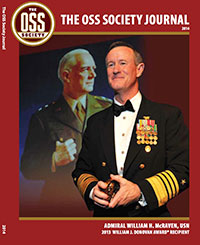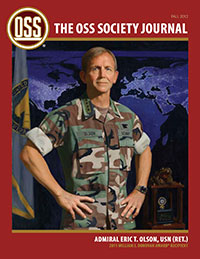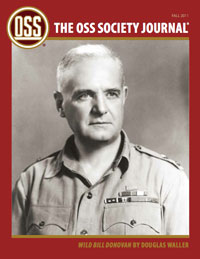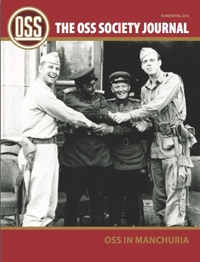Congressman Charles Rangel presents Bronze Star posthumously awarded to Joseph Gould by US Army Decorations Board
February 2010

However, because of the extended period of time that OSS personnel files remained classified, Joseph Gould was never able to claim his award before his death in 1993. Now, because of the release of these personnel files to the National Archives in August 2008, the long wait endured by his family has finally ended. With the support of Congressman Rangel’s office, the Army Decorations Board reviewed documents obtained from Joseph Gould’s personnel file showing that he had been recommended and approved for the Bronze Star after the war. As a result, the Board formally approved the release of the medal to Congressman Rangel and requested that he present it to Jonathan Gould on behalf of Joseph Gould’s family.
Within months after the United States entered World War II following the Japanese attack on Pearl Harbor in December 1941, Joseph Gould enlisted in the US Army. Because of training he received from the Officer Reserve Corp while attending Columbia Journalism School, he was commissioned as a Second Lieutenant and ordered to report for basic infantry training at Camp Croft in South Carolina in July 1942.
Shortly thereafter, Joseph Gould’s background as a white collar union official in New York for the Screen Publicists Guild attracted the attention of the Office of Strategic Services. The OSS had just begun cultivating exiled anti-Nazi trade unionists to lead intelligence gathering missions behind enemy lines. There was a need for military officers with labor union experience to recruit and train these men. As a result, Joseph Gould was recruited into the OSS in 1943 and ordered to report to its top secret training facility at the newly converted Congressional Country Club in Bethesda, Maryland. In the spring of 1944, Army Lt. Joseph Gould received his orders to ship out and report to the Labor Desk of the London office of the OSS.
 Joseph Gould would soon become a key player in the German Penetration Campaign launched by the OSS following the Allied invasion of France. In August 1944, the London office of the OSS Secret Intelligence Branch prepared the blueprint for this campaign and presented it to Allied military commanders. That document was called the Faust Plan and it outlined how the OSS would penetrate Nazi Germany. The plan’s objective: the collection of secret intelligence by means of espionage to be carried out by agents recruited from within dissident anti-Nazi groups now living in exile in England and Sweden. It provided a roadmap for the planning and execution of over 50 missions that were dispatched into Germany under the leadership of William J. Casey, chief of the OSS Special Intelligence, during the final months of the war against Hitler.
Joseph Gould would soon become a key player in the German Penetration Campaign launched by the OSS following the Allied invasion of France. In August 1944, the London office of the OSS Secret Intelligence Branch prepared the blueprint for this campaign and presented it to Allied military commanders. That document was called the Faust Plan and it outlined how the OSS would penetrate Nazi Germany. The plan’s objective: the collection of secret intelligence by means of espionage to be carried out by agents recruited from within dissident anti-Nazi groups now living in exile in England and Sweden. It provided a roadmap for the planning and execution of over 50 missions that were dispatched into Germany under the leadership of William J. Casey, chief of the OSS Special Intelligence, during the final months of the war against Hitler.
Joseph Gould was appointed the recruitment and training officer for a group of five missions collectively called the TOOL missions. He successfully recruited seven anti-Nazi German exiles then living in London during the fall of 1944 to lead these missions. According to the Bronze Star medal recommendation prepared in June 1945 by US Army Colonel James R. Forgan, the successful recruitment of the Free Germany Committee exiles was “entirely due to Joseph Gould’s exceptional tact and diplomacy in skillfully handling these contacts.” Ultimately, Joseph Gould was charged with the responsibility of training the German exiles for their missions and “displayed rare ingenuity and imagination in his briefing and preparation of these men.” In concluding his recommendation for the award of the Bronze Star to Joseph Gould, Colonel Forgan lauded his “great devotion to duty” and that he had “played an essential part in preparing and activating important missions from which valuable results were obtained.”
Of the five TOOL missions, two were later considered by OSS historians as being very successful. The HAMMER mission into Berlin, led by two natives of that city -- Paul Lindner and Anton Ruh -- was dispatched in early March 1945. According to Colonel Forgan, “vital information was obtained as to conditions in Berlin, the disposition of troops in the Berlin area and remaining targets for bombing by the US Air Force.” In 2004, the US Army Decorations Board posthumously awarded the Silver Star to the men of the HAMMER mission. In addition, the work of the team of agents that led the PICKAXE mission into the southern German city of Landshut was later praised by William J. Casey, who wrote in his memoir that “the agents funneled massive amounts of information about rail and road traffic, communications centers and troop movements.”

Joseph Gould was appointed the recruitment and training officer for a group of five missions collectively called the TOOL missions. He successfully recruited seven anti-Nazi German exiles then living in London during the fall of 1944 to lead these missions. According to the Bronze Star medal recommendation prepared in June 1945 by US Army Colonel James R. Forgan, the successful recruitment of the Free Germany Committee exiles was “entirely due to Joseph Gould’s exceptional tact and diplomacy in skillfully handling these contacts.” Ultimately, Joseph Gould was charged with the responsibility of training the German exiles for their missions and “displayed rare ingenuity and imagination in his briefing and preparation of these men.” In concluding his recommendation for the award of the Bronze Star to Joseph Gould, Colonel Forgan lauded his “great devotion to duty” and that he had “played an essential part in preparing and activating important missions from which valuable results were obtained.”
Of the five TOOL missions, two were later considered by OSS historians as being very successful. The HAMMER mission into Berlin, led by two natives of that city -- Paul Lindner and Anton Ruh -- was dispatched in early March 1945. According to Colonel Forgan, “vital information was obtained as to conditions in Berlin, the disposition of troops in the Berlin area and remaining targets for bombing by the US Air Force.” In 2004, the US Army Decorations Board posthumously awarded the Silver Star to the men of the HAMMER mission. In addition, the work of the team of agents that led the PICKAXE mission into the southern German city of Landshut was later praised by William J. Casey, who wrote in his memoir that “the agents funneled massive amounts of information about rail and road traffic, communications centers and troop movements.”







